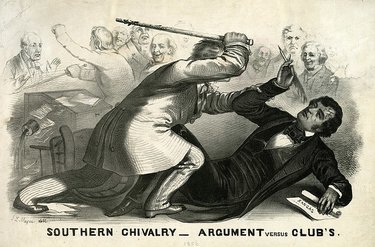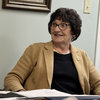New Scotland makes plans to mark history, improve parks, maintain vacant properties
— 1856 lithograph in the Boston Athenæum collection
Samuel Dickson, an anti-slavery New Scotland doctor, served in the 38th Congress during which Representative Preston Brooks of South Carolina used his cane or pieces of it after it splintered, to beat Massachusetts Senator Charles Sumner on the Senate Floor after Sumner gave a passionate speech denouncing pro-slavery members. The incident came to represent the nationwide polarization before the Civil War. A historical marker recognizing Dickson is in the works.
NEW SCOTLAND — The town continues to mark its history, will perhaps recast a bill to maintain vacant property, and continues with plans for its playgrounds and century-old barn-turned-gathering place.
All of these were discussed at the Sept. 13 town board meeting.
Supervisor Douglas LaGrange spoke of an unnamed man who died in a townhouse in an unnamed development in New Scotland that does not have a homeowners’ association. The man’s side of the house has been vacant “quite a while,” LaGrange said and it’s “very hard to make sure it’s kept up.”
Several people have called, he said, and when electricity is shut off a sump pump won’t work.
When LaGrange suggested a law, the town’s attorney, Michael Naughton, noted that had been tried, stating there were “a lot of very good comments from the public.”
In August 2022, many residents had voiced their objections to the proposed law, which sought to “provide for the proper maintenance of residential, commercial, and industrial properties” in town “to prevent blight, unhealthy, hazardous, or unsightly conditions due to the accumulation of brush, grass, weeds, garbage or rubbish in order to protect the public, health, safety and general welfare of the residents ….”
Opposition crossed party lines.
Democratic Albany County Legislator Vicki Plotsky, speaking only as a town resident, said at the 2022 hearing that she appreciated that the town needs a mechanism for enforcing some sort of standard, but she also appreciated living in a rural area and not having to conform to the suburban ideal of a perfect lawn.
“Part of me feels like we moved out of Delmar for a reason,” she said. Plotsky said she’d like to have “the freedom, if you will, to basically have our property as we wish to maintain it.”
Peter Drao, who ran unsuccessfully in 2022 for a seat on the town board and is running again this year, both times on the GOP ticket, was also opposed to the proposed local law.
Drao said at the 2022 hearing that the “ordinance would impose homeowner association-like standards on any place in town that’s not zoned farm, rural, or natural open space.” He believed the proposed local law went beyond the intent of the state state building code, and “would constitute an intrusion on the private property rights of town residents.”
Naughton told the town board on Sept. 13 that he could revise the 2022 bill and “do the minimum,” focusing more on “the safety stuff.”
“We should just get at it and give it another try,” Naughton said, to which the board agreed.
Marking history
Councilman Daniel Leinung reported that the New Scotland Historical Association had secured a marker from the Pomeroy Foundation to identify the Onesquethaw Valley Historic District, which had been listed on the national register 49 years ago.
The marker has been placed along Route 32 and was dedicated in a ceremony on Sept. 9. The district follows the Onesquethaw Creek, often near present-day Route 32, from the end of Lower Flat Rock Road to just southeast of Feura Bush.
Leinung also reported that a marker to commemorate Samuel Dickson is in the works. Dickson, he said, was the only person born in New Scotland to serve in Congress.
Dickson’s house was where Corner Gateway is now, at the intersection of Routes 85 and 85A, Leinung said, but the Pomeroy Foundation, which is supplying the marker, believes it is confusing to place a marker by a current structure if the original structure no longer stands.
Dickson was born in 1807 and the Corner Gateway is housed in what was a Victorian home, which was built well after 1807. Leinung said a site on the Town Hall property is being considered for the marker.
Dickson, a doctor, served in the 34th Congress, from 1855 to 1857, at time of great turmoil nationwide as pro-slavery and anti-slavery supporters battled it out in the “Bleeding Kansas” territory.
This was the Congress where, on May 22, 1856, after Massachusetts Senator Charles Sumner vehemently denounced pro-slavery members, Representative Preston Brooks of South Carolina beat Sumner on the Senate Floor, using his cane or pieces of it after it splintered. The incident came to represent the nationwide polarization before the Civil War.
Dickson, who was against slavery, was elected as an Opposition Party candidate to represent New York’s 14th Congressional District; he was preceded by Rufus Peckham of Rensseleaeville, the father of a Supreme Court justice with the same name, and he was succeeded by Erastus Corning, Albany’s mayor from 1834 to 1837, whose great-grandson, Erastus Corning 2nd, was Albany’s mayor from 1942 to 1983.
A “biographical sketch” written in 1864 by S. H. Freeman, M.D. for the Medical Society of Albany County tells Dickson’s life story: He was born, on March 29, 1807, in the hamlet of New Scotland when it was still part of the town of Bethlehem.
His father, William Dickson, had been born in Scotland and entered the British Navy as a boy, emigrating soon after to the United States. “Having acquired a competency at the wheelwright’s trade,” writes Freeman, “he purchased a farm in the village of New Scotland where Dr. Dickson, his only son, resided until the time of his decease, May 5, 1858.”
At age 16, Dickson entered the junior class of Union College and graduated in 1825, “the youngest and one of the most promising members of the class.”
He studied medicine in Albany under Dr. William Bay and in 1829 “received a diploma from the Censors of the Medical Society of the State of New York.” Dickson then started a practice in his native town “and soon acquired the confidence of the community and considerable reputation as a judicious and skillful physician.”
After Dickson was elected to Congress, Freeman writes, “His integrity of character and unyielding firmness on all questions of principle and duty soon won for him the respect of his associates.”
However, an accident near the close of Dickson’s first congressional session ultimately led to his death, which Freeman describes this way:
“The accident occurred in his own room, during a temporary recess of the house, under the following circumstances: being desirous of consulting a book in his library he hastily arose from his chair, which he inadvertently overturned, and in attempting to resume his seat without looking around he fell with considerable force upon the floor.”
Dickson was able to recover enough from this “concussion of the spine” to resume his work in Congress and his medical practice. “But his strength gradually declined,” Freeman wrote, “until within about three months of his decease, when his lower extremities became completely paralyzed.”
“His mind however, remained clear and undisturbed,” Freeman concludes, “and though conscious that his days on earth were numbered, he was enabled to rejoice in the unfailing hope and consolation which is alone imparted by a Christian faith. His age was 51 years.”
He is buried in the cemetery of New Scotland’s Presbyterian Church.
Parks and playgrounds
Councilman William Hennessy told the board that plans for the Hilton Barn are “98 percent completed.”
In 2016, the town saved the massive post-and-beam barn — it’s 60 feet wide, 60 feet tall, and 120 feet long — when it was slated for demolition to make way for a housing development. Joseph Hilton had Frank Osterhout build the barn on his New Scotland farm in 1898.
The barn was moved across Route 85A from its original location and is now surrounded by parkland, which is adjacent to Albany County’s popular Helderberg-Hudson Rail Trail.
“Currently the barn is under renovation,” Hennessy said at the board’s Sept. 13 meeting, noting “significant progress” with new siding on the first floor and staining of the entire barn. The town also contracted for a new slate roof for the barn.
Inside, Hennessy said, bathrooms will be built along with “community space” and there will be a stage outside. An ice-skating rink is also planned.
Hennessy is also seeking comments for plans to additions to the town’s playgrounds, which the board plans to discuss on Sept. 27 at 6:30 p.m.
The board also set dates for a presentation of the town’s budget on Oct. 2 with budget workshops on Oct. 5, 9, and 17, and a public hearing on Nov. 8.



